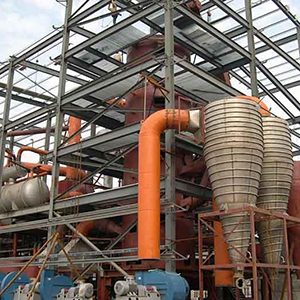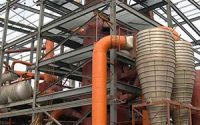Solvent extraction process of soybean
Solvent extraction of soybean
- Basic principles and elements of solvent extraction
Oil extraction is to extract the oil from the embryo by wetting and infiltration, molecular diffusion and convective diffusion with solvent which can dissolve the oil. The mixture of solvent and fat is then separated to recover the solvent to obtain the crude oil. It is also necessary to recover the solvent in the soybean meal and obtain the solvent extracted meal. In this process, the basic elements are solvent and material embryo, and the solvent extraction methods and technological parameters that determine the extraction effect.

- Process of solvent extraction
Solvent extraction is the main process of oil extraction.In the extraction process, the full contact between the solvent and the embryo of the material is realized through a specific extraction device and a reasonable extraction mode, so as to achieve the purpose of fully dissolving oil and extracting oil.
(1)The way of extraction refers to the contact mode between solvent and material embryo in the process of oil extraction.Here’s three modes:
- Immersion:The material embryo is always soaked in solvent (or dilute mixed oil) to complete the extraction process.In this way, the extraction time is short, the mixed oil content is large, but the concentration is thinner, that is, the oil content in the mixed oil is less, and the residue content in the mixed oil is more.
- Infiltration:The contact process between solvent and material embryo is always in spray-permeation state. After leaching, the concentrated mixed oil with high oil content can be obtained, and the residue content in the mixed oil is also small. But the extraction time is longer.
- Soaking and spray mixed:At first, soak the material embryo and spray the permeation, which improves the extraction rate and the oil production efficiency, and reduces the leaching time.
(2)Leaching process conditions
The requirement of leaching temperature and leaching time and leaching temperature is consistent with the temperature of the material embryo, and the solvent should be preheated first.
Theoretically speaking, the longer the extraction time is, the better the effect and residual oil rate is.In the actual production, the oil leaching process can be divided into two stages. The first stage is mainly to dissolve the oil in the damaged cells by solvent. The extraction amount is large and the time is short(15~30 minutes), and the total oil content can be extracted from 85% to 90%.In the second stage, solvents are needed to penetrate into the unspoiled cells for a long time with low efficiency. The optimal “economic time” should be considered according to the actual situation.
(3) type of extractor
It is generally divided into continuous type and intermittent type, and then into soaking type, permeating type and mixed type according to leaching method.
Each kind of leaching equipment is divided into many types of structure, among which the single fou and fou group have been gradually eliminated due to the high intensity of labor due to intermittent production.
The leaching efficiency is high and the process is advanced, which has been widely used, but the cost is high.
- Dissolving of wet meal
The wet meal from the extractor usually contains 21 to 40% solvents.It is necessary to recover the solvent and reduce the moisture content in the meal after dissolving and drying, so as to reach the prescribed residual solvent volume index (500 ~ 1000ppm) and the safe storage of water.The process of recovering solvent is called dissolving, and the process of drying and dehydrating is called baking meal.
- Basic process of dissolving and baking meal
The dissolving stage is mainly through direct steam passing through the material layer, which makes the solvent boil and volatilize after contact and heat transfer. Direct steam is used as heat source for heating solvent, and pressure is evaporated with solvent.But at the same time, when steam is heated, the water vapor will also partially condensed into water droplets stored in the meal, which will increase the moisture content of soybean meal.Therefore, it is necessary to remove moisture from the roast meal, and the roast meal is usually heated by indirect steam to remove moisture.
2. Basic methods of dissolving and baking meal
①.The high temperature dissolving method is direct steam with the pressure of 0.5kg/cm2, which is steamed for 30~40 minutes through the thick layer of 1.5m, and then dries the water with the indirect steam of 4 ~ 5kg/cm2 by pressure, in order to meet the requirement of the specified water content.The temperature of the dregs is above 105℃. The degeneration of this meal protein is not conducive to further processing and utilization of protein.
②.The flash pre-desolvation (low temperature desolvation) process uses a high-speed superheated solvent vapor to blow the wet meal to a cyclone separator to remove the solvent in a very short time.After dissolving, the meal is fed into the feeder by gravity and enters the evaporating cooler.The steam-drying cooler maintains a vacuum of 200-400 mm Hg. A small amount of direct steam is used in the upper part to remove the residual solution. The lower part is blown into the dry cold air to remove the moisture.In this way, the heating time of the soybean meal is short, the drying temperature is low, the water vapor is directly acted on, the temperature of the meal is not more than 70~80℃, so the protein denaturation rate is low, only 1 ~ 2%, which is beneficial to the further development and utilization of the protein.
③.In order to save steam, mechanical extrusion method is sometimes used to extrude some solvents before thermal dissolving and baking meal.
The main equipment of the dissolving roasting meal is multi stage horizontal dryer, high material layer drying and steam drying cooler.
- Evaporation of miscella
The oil content in the concentrated mixture obtained from the leaching process is generally 10 to 30%.In order to get the crude oil, the solvent must be evaporated from the mixed oil. The residual solvent index in the crude oil is 50-500 ppm.
Removing the solvent from the mixed oil is characterized by the lower boiling point of the solvent than the boiling point of the oil. The mixture is heated by heating to boil the mixed oil, so that the solvent is vaporized and the oil is retained.However, as the solvent and oil are homogeneous intersoluble liquids, the boiling point of the solvent increases with the increase of the concentration of the mixed oil under a certain pressure or vacuum.
It can be seen that heating evaporation is not only the solvent in the mixed oil, but also must be combined with the stripping method. The conventional separation of mixed oil can be divided into two steps:
①The mixed oil evaporates, which is heated by indirect steam and evaporated by solvent.
②Stripping:At the temperature of 110~115 C, the input pressure is 0.2 ~ 0.5kg/cm2 of direct steam, so that a small amount of solvent in the mixed oil is taken away with the steam to remove the residual solvent.
Evaporation equipment commonly used long tube or evaporator, stripping equipment has lifting membrane type, tube type, stripper and so on.
- Recovery of solvent
In addition to solvent recovery and high output, the solvent recovery system will also add tail gas recovery system in order to recover and use useful solvent once again .It is usually mineral oil as a medium.
Main solvent recovery:Each place corresponds to a condenser, totally consisting of 6 condensers,The solvent steam from each place are condensed into the vacuum condenser, and the condensed liquid enters the water separation tank. After separating the solvent from the water, the solvent enters into the solvent holding tank to continue to recycle. Each condenser is not interworking and can be used in parallel or continuously in parallel.The gas haven’t been condensed needs to enter the final condenser, the condensed liquid enter to the water absorption tower, and then directly enter the water separation tank. After removing out the water in the solvent, it enters the solvent holding tank.
The tail gas was recovered through stripping stripping and mixing oil evaporation stripping process. The equipment includes condensers, water separators, distilled water and tail gas recovery devices.


